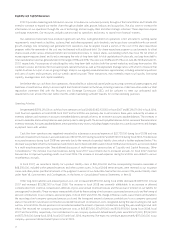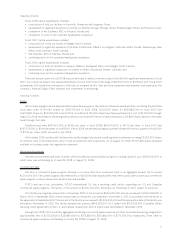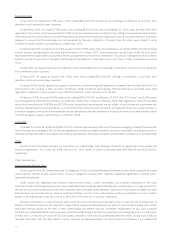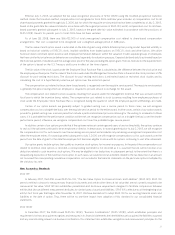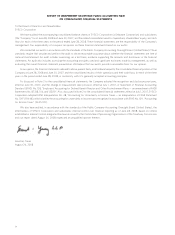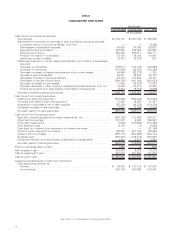Sysco 2008 Annual Report Download - page 52
Download and view the complete annual report
Please find page 52 of the 2008 Sysco annual report below. You can navigate through the pages in the report by either clicking on the pages listed below, or by using the keyword search tool below to find specific information within the annual report.goodwill acquired in a business combination and disclosure requirements to enable financial statement users to evaluate the nature and
financial effects of the business combination. We will apply this statement primarily on a prospective basis for business combinations
beginning in fiscal 2010. Earlier application of the standard is prohibited.
FSP 157-2
In September 2006, the FASB issued SFAS No. 157, “Fair Value Measurements” (SFAS 157), which establishes a common definition for
fair value under generally accepted accounting principles, establishes a framework for measuring fair value and expands disclosure
requirements about such fair value measurements. In February 2008, the FASB issued FASB Staff Position 157-2, “Effective Date of FASB
Statement No. 157” (FSP 157-2), which partially defers the effective date of SFAS No. 157 for one year for non-financial assets and liabilities
that are recognized or disclosed at fair value in the financial statements on a non-recurring basis. Consequently, SFAS 157 will be effective for
SYSCO in fiscal 2009 for financial assets and liabilities carried at fair value and non-financial assets and liabilities that are recognized or
disclosed at fair value on a recurring basis. As a result of the deferral, SFAS 157 will be effective in fiscal 2010 for non-recurring, non-financial
assets and liabilities that are recognized or disclosed at fair value. We believe the adoption of SFAS 157 in fiscal 2009 for financial assets and
liabilities carried at fair value and non-financial assets and liabilities that are recognized or disclosed at fair value on a recurring basis will not
have a material impact on our consolidated financial statements. We are continuing to evaluate the impact of adopting the provisions of
SFAS 157 in fiscal 2010 for non-recurring, non-financial assets and liabilities that are recognized or disclosed at fair value.
SFAS 161
In March 2008, the FASB issued SFAS No. 161, “Disclosures about Derivative Instruments and Hedging Activities, an amendment of
FASB Statement No. 133” (SFAS 161). SFAS 161 requires enhanced disclosures about an entity’s derivative and hedging activities and thereby
improves the transparency of financial reporting. This statement will be effective for SYSCO’s financial statements beginning with the third
quarter of fiscal 2009. We are currently evaluating the impact the adoption of SFAS 161 may have on its financial statement disclosures.
Forward-Looking Statements
Certain statements made herein that look forward in time or express management’s expectations or beliefs with respect to the
occurrence of future events are forward-looking statements under the Private Securities Litigation Reform Act of 1995. They include
statements about SYSCO’s ability to increase its sales and market share and grow earnings, the continuing impact of economic conditions
on consumer confidence and our business, expense trends, anticipated multi-employer pension related liabilities and contributions to
various multi-employer pension plans, the outcome of ongoing tax audits, the impact of ongoing legal proceedings, the loss of SYSCO’s
largest customer not having a material adverse effect on SYSCO as a whole, compliance with laws and government regulations not having a
material effect on our capital expenditures, earnings or competitive position, long-term debt to capitalization ratios, anticipated capital
expenditures and the sources of financing for those capital expenditures, continued competitive advantages and positive results from
strategic business initiatives, anticipated company-sponsored pension plan liabilities, the availability and adequacy of insurance to cover
liabilities, the impact of future adoption of accounting pronouncements, predictions regarding the impact of changes in estimates used in
impairment analyses, the anticipated impact of changes in foreign currency exchange rates and SYSCO’s ability to meet future cash
requirements and remain profitable.
These statements are based on management’s current expectations and estimates; actual results may differ materially due in part to
the risk factors discussed at Item 1.A. above and elsewhere. In addition, the success of SYSCO’s strategic business initiatives could be
affected by conditions in the economy and the industry and internal factors such as the ability to control expenses, including fuel costs. The
ability to meet long-term debt to capitalization ratios also may be affected by cash flow including amounts spent on share repurchases and
acquisitions and internal growth. Company-sponsored pension plan liabilities are impacted by a number of factors including the discount
rate for determining the current value of plan benefits, the assumption for the rate of increase in future compensation levels and the expected
rate of return on plan assets. Legal proceedings are impacted by events, circumstances and individuals beyond the control of SYSCO.
Predictions regarding the future adoption of accounting pronouncements involve estimates without the benefit of precedent, and if our
estimates turn out to be materially incorrect, our assessment of the impact of the pronouncement could prove incorrect, as well. The
anticipated impact of compliance with laws and regulations also involves the risk that estimates may turn out to be materially incorrect, and
laws and regulations, as well as methods of enforcement, are subject to change.
Item 7A. Quantitative and Qualitative Disclosures About Market Risk
Interest Rate Risk
We do not utilize financial instruments for trading purposes. Our use of debt directly exposes us to interest rate risk. Floating rate debt,
where the interest rate fluctuates periodically, exposes us to short-term changes in market interest rates. Fixed rate debt, where the interest
rate is fixed over the life of the instrument, exposes us to changes in market interest rates reflected in the fair value of the debt and to the risk
that we may need to refinance maturing debt with new debt at higher rates.
We manage our debt portfolio to achieve an overall desired position of fixed and floating rates and may employ interest rate swaps as a
tool to achieve that goal. The major risks from interest rate derivatives include changes in the interest rates affecting the fair value of such
28




